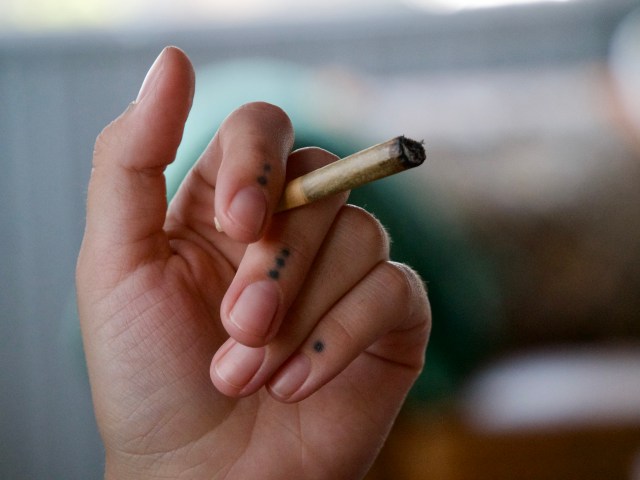Marijuana, once considered as dangerous as heroin, is now as commonplace as a beer in some states. The shift in perception has been drastic in recent years, experts say. (Joe States/Lake County News-Sun)
A few weeks ago, representatives of Terrabis stood before the Mundelein Village Board discussing their proposal to turn a former bank building into their newest cannabis shop location.
The board members were deciding whether or not to give a thumbs-up to the company to move ahead with more planning. The company’s co-founders had backgrounds in the corporate world of McDonald’s and Insomnia Cookies, and their shop’s design looked closer to a new fast-food restaurant than a drug store.
As the trustees shared their views, two voiced their opposition, with one noting its proximity to a playground. When Trustee Kara Lambert spoke, she said that as a mother she has reservations about cannabis.
A customer at Spark’d in Winthrop Harbor scrolls through a list of cannabis products on a digital screen. The store is brightly lit, with a patio for guests to play boardgames and relax. (Joe States/Lake County News-Sun)
But, with a shrug, Lambert said she didn’t consider the proposed shop as much different from a bar, and gave it a thumbs up.
The scene was an example of how different the cannabis industry and its perception have become since its legalization in states across the country, including Illinois in 2019. Today, executives with backgrounds in corporate America pitch sleek stores to local boards who, as Lambert and her fellow trustees showed, largely support such businesses moving forward, hesitations driven by motherly instincts notwithstanding.
‘Reefer Madness’
According to Richard Miller, an emeritus professor in the Department of Pharmacology at the Northwestern University Feinberg School of Medicine, perceptions related to marijuana have changed repeatedly throughout history.
Cannabis goes back beyond recorded history, he said, and had an “enormous number” of medical benefits in ancient times.
But, the public perception of cannabis in the U.S. would change drastically in the 20th century, becoming illegal in the late 1930s, he said. It was later taken up by the counterculture movement in the 1960s, along with psychedelics, and the administration of President Richard Nixon labeled it as a Schedule I drug in 1971, putting it in the same category as heroin and LSD.
It was “completely demonized,” Miller said, and made out to be “absolutely dangerous,” potentially even fatal. He pointed to the film “Reefer Madness,” a 1936 anti-marijuana movie that he said shows the level of paranoia around marijuana at the time.
“It’s just completely bonkers,” he said.
A rendering of the proposed Terrabis cannabis shop in Mundelein. The proposal reflects the drastic change in perception of cannabis and the industry at large. (Image courtesy of Village of Mundelein)
Miller and Ashlee Humphreys, a professor at Northwestern University who studies the legitimization process for industries, both noted that cannabis use was used to stigmatize marginalized communities, including people of color, immigrants and low-income individuals. But in the decades since, perceptions have shifted, Humphreys said.
“We’ve seen that change,” she said. “The stigma with marijuana use is really just not as present as it was even 20 or 30 years ago.”
The real turning point in the perception of cannabis can be credited, or blamed, on mothers, Humphreys said.
“I think when it went over to moms, that was the new test,” she said. “If moms are using it, it’s legitimate.”
Since its legalization in Colorado, Humphreys said she’s seen it grow from a “niche industry” into a “big business.” Today, there’s a “critical mass” of states that have legalized cannabis.
In the early days, the industry was run by enthusiasts, young entrepreneurs and small businesses, she said. Now, as seen with the Mundelein proposal, the people getting involved come from the business world because there’s good money to be made.
The interior patio of Spark’d, a cannabis store in Winthrop Harbor. Store manager Jennifer Cruz said she sees all sorts of people, from grandparents to police officers, mingle at their shop. (Joe States/Lake County News-Sun)
Aleks Glass, director of product for Spark’d, which runs several cannabis shops throughout Illinois, said the industry has become a legitimate career option for some. It’s seen steep growth in recent years, with a rise in dispensaries and the types of products being sold. He admitted it is a “crowded spot” in some ways.
Humphreys said that in Illinois, cannabis is generally accepted and well on its way to legitimacy, and both the consumers and the product types have expanded in recent years. Instead of smoking, there’s been a rise in gummies, patches and other methods of ingestion. Groups who have never tried cannabis before are also giving it a go.
“It’s really just a broadening of the market, where you have consumable products that are perhaps more appealing to a broader audience, and you have also a broader audience who’s willing to try cannabis,” she said.
The retail spaces have changed to match.
“Many of the retail stores where we did our research, they look like Apple stores,” Humphreys said. “They’re really modeled on just normal, legitimate businesses. You can see that not only in the product, but also in retailing.”
One example in Lake County is the Spark’d cannabis shop in Winthrop Harbor. The interior is full of light, with colorful decorations and high-tech touch-screens for purchasing a range of products. A decorated patio area offers board games and a place to relax.
It sits only a few minutes from the Wisconsin state border, and store manager Jennifer Cruz said she sees the difference between Illinois and Wisconsin buyers.
“They’re always so nervous,” she noted.
But today’s cannabis businesses are a far cry from “hitting up a guy you meet in an alleyway,” Cruz said, laughing. “You know exactly what it is you’re getting, and it’s such a nice, easy experience.”
Cruz sees the “broader audience” Humphreys talked about every day, including some of her former grade school teachers, grandparents and even police officers.
“People have that idea of what the typical stoner is, but truthfully that doesn’t exist,” Cruz said. “It’s really fun to see all these different people come in and interact, that you wouldn’t think would normally have interactions with each other.”
Cannabis branding today is far friendlier, associating with wellness and mindfulness, Humphreys said. But she cautioned that some of the branding can be a little too friendly, such as with marijuana candies that could confuse young children.
“It’s growing, and that’s a good thing for the industry … but I think people in the industry should also be cautious about exactly how they’re growing and trying to see ahead in terms of obstacles,” she said.
Glass also shared some concerns about the industry at large. He feels there is a lack of regulation for some products being sold at gas stations and grocery stores.
“I think more consistent education the industry can provide to the consumers is the next step for creating a more equitable industry for both employees and consumers,” he said.
‘Tip of the iceberg’
The shift could open up real medical breakthroughs in any number of areas. Miller pointed to a 2017 report from the National Academy of Sciences that discusses the wide-ranging claims about the effects of different chemicals from cannabis.
He cautioned that there is plenty of false information also circulating, but noted several generally accepted claims, such as its potential to inhibit emesis sickness in cancer patients and help some patients with pain.
Various chemicals come from cannabis, with the most commonly discussed being THC. It’s only “the tip of the iceberg,” Miller argued, of “a whole world of cannabis molecules.”
But any in-depth research into the medical aspects of cannabis is complicated by the fact that it’s still illegal at the federal level, cutting off grant funding, he said.
“Most are in a kind of gray area,” Miller said. “It’s difficult because it’s been hard to do clinical trials with cannabis, which are considered to be the gold standard of what the medical profession accepts.”
That gray area means doctors aren’t getting training related to cannabis in school, despite the potential benefits it could provide to some patients.
“Most people go to their doctor … and say, ‘Should I take some cannabis?’” Miller said. “The doctor has no freaking idea what to tell them, because they don’t know anything about it. The normal medical profession, like the doctors you go and see every day, has very little idea what to make of cannabis at all.”
There are risks to consider, Miller said. People can react to drugs differently, including marijuana. And much like with drinking, driving while intoxicated is dangerous. Miller also recounted stories of people he’s known who had bad trips.
“They didn’t die or anything like that, but there are dangers,” he said. “And if you decide you’re going to sit in your dungeon and do nothing but smoke 24 hours a day, there’s probably some dependency that can occur.”
For now, it’s still an arena full of both misleading information and untapped potential, but Miller predicted cannabis will one day be “a much wider aspect of medicine,” and he expects the larger pharmaceutical companies to step in at some point.


